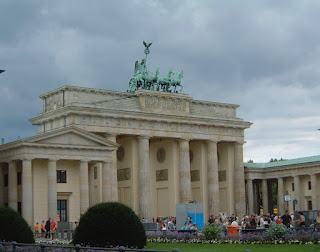In November, Germany, and the world,
will celebrate the 30th anniversary of the fall of the Berlin
Wall. Overnight ‘The Fall of the Wall’ not only changed an entire nation,
but it also changed the rest of the world. The reunification of Germany ended
28 years of terror that tore apart families, friends and neighbors.
A visit to Berlin reveals a rejuvenated city that is no longer divided…a
free city that that is celebrating reunification and democracy…a city that
has confronted its past and is forging ahead to the future.
 |
| FORMER BERLIN WALL…NOW THE EASTSIDE GALLERY |
Emotionally, visitors of all religions
are volleyed between the delights of their time in Berlin and the poignant
reminders of the terrible years under the Third Reich. Architecturally,
Berlin is a smorgasbord of architectural masterpieces, scanning
centuries. From the original Reichstag to Sir Norman Foster’s glass-domed
roof…from the original Jewish Museum…to Daniel Libeskind’s 21st
century addition to the structure…to Frank Gehry’s space age DZ Bank lobby.The
Reichstag, the seat of Germany’s Parliament, originally opened in
1894. After the reunification of Germany, the building was fully
restored by internationally renowned architect Sir Norman Foster.
Completed in 1999, the restoration features an iconic large glass dome that has
a 360-degree view of the surrounding cityscape. Lunch at the top of the
Reichstag is overpriced, but worth it just for the experience and the
view. Outside of the Reichstag is a memorial to the 96 Reichstag members
of opposition parties killed by the Nazis.
 |
| GLASS DOME OF THE REICHSTAG |
The baroque Jewish Museum of Berlin,
built is 1735, first served as the Collegienhaus (Supreme
Court building) for the Royal Court of Justice. World-renowned architect Daniel
Libeskind’s eerie addition to the museum culminates with the horrors of
Hitler’s persecution and extermination plans. Sole access into the
new addition, is through the historical Collegienhaus.
 |
| LIBESKIND’S MODERN ADDITION TO 1735 JEWISH MUSEUM |
The Libeskind addition has three main
corridors: the Axis of Continuity, the Axis of Emigration, and the Axis of the
Holocaust. The Axis of Continuity connects the old building with the new
addition. The architect described that axis as the continuation of Berlin’s
history from which the other axes branch off. The Axis of Emigration
leads outside to the Garden of Exile that Libeskind said attempts “to
completely disorientate the visitor. It represents a shipwreck of
history.” In the Axis of the Holocaust, Libeskind stated that the bare
concrete Holocaust Tower, with a narrow slit at the top, “is the space which
somehow ends the old history of Berlin.”
Nearby is the Brandenburg Gate
(1788-1791), the city’s most famous landmark. The centerpiece of the
Pariser Platz, the Brandenburg Gate is the symbol of Berlin’s
reunification. It is crowned with the 18th century
Quadriga Statue that depicts the
Goddess of Victory driving a chariot pulled by four horses.
 |
| THE BRANDENBURG GATE |
On the south side of Pariser Platz,
between the Brandenburg gate and the Hotel Adlon, is the DZ Bank headquarters, one of architect Frank Gehry’s most
interesting buildings. Strict
urban planning regulations for buildings in the center of Berlin made it
impossible for Gehry to erect one of his sculptural masterpieces such as the
Guggenheim in Bilbao. Therefore, he solved the problem by putting his
traditional Gehry touch within the entrance area in the form a 4-story-high,
steel-clad, wood-lined shell that seems
as if it is floating in space.
This sculptural structure serves as the building’s primary conference hall.
 |
| FRANK GEHRY’S DZ BANK LOBBY |
One block south of the Brandenburg gate
is Peter Eisenman’s Memorial to the Murdered Jews of Europe, also known as The
Holocaust Memorial. The 2,711 concrete slabs (stelae)
of differing heights are set in a grid pattern on a sloping field. Eisenman’s
project text explains that the stelae
are designed to produce an uneasy, confusing atmosphere, and the whole
sculpture aims to represent a supposedly ordered system that has lost touch
with human reason.
 |
| EISENMAN’S HOLOCAUST MEMORIAL |
The
East Side Gallery, a long section of the Berlin Wall near the center of Berlin,
is the largest open-air gallery in the world. It is a place where the old Berlin
meets the new Berlin. More than 100 murals, by artists from around the
world, cover this memorial for freedom. The association of the artists involved in the project stated
"The East Side Gallery is understood as a monument to the fall of the
Berlin Wall and the peaceful negotiation of borders and conventions between
societies and people". More than three million people visit the wall every year.
 |
| RENOWNED MURAL-LEONID BREZHNEV & ERICH HONECKER |
It’s
tacky and touristy, but one cannot go to Berlin without taking in the sight
known as Checkpoint Charlie. Checkpoint Charlie was the crossing point between
East Berlin and West Berlin during the Cold War. It was the
crossing point for foreigners, diplomats, and members of the Allied forces. The ersatz
guardhouse, with its ersatz soldiers standing guard, is a favorite photo
op for tourists. The Checkpoint Charlie Museum is a private commercial venture,
but it does have some interesting exhibits such as escape cars, a small
submarine, and amazing stories about how some
people attempted to escape.
 |
| CHECKPOINT CHARLIE |
If,
by now, you are in desperate need of a shopping fix, there are plenty of
souvenirs at Checkpoint Charlie. Mostly schlock…but good mementos.
Janet Steinberg, winner
of 47-travel writing awards, resides in Cincinnati but calls the world her home.

No comments:
Post a Comment